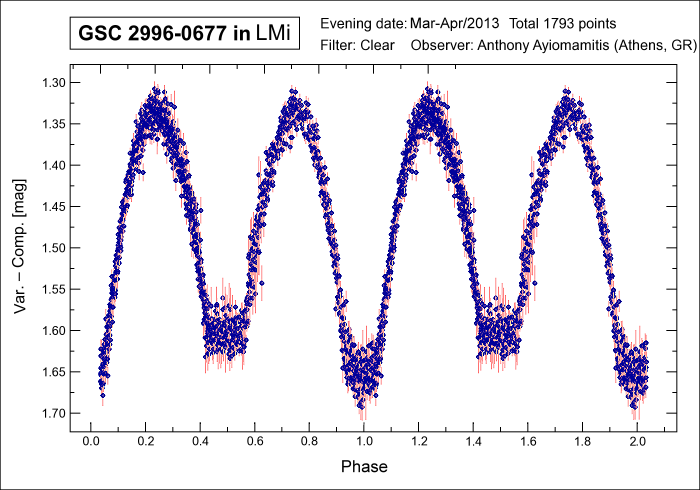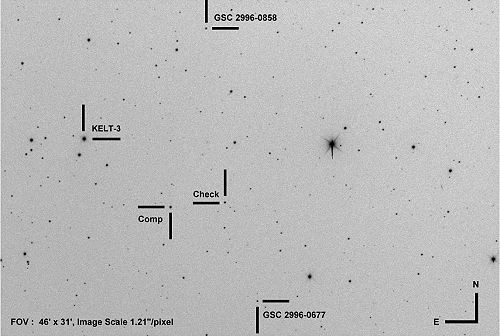| Article in PDF |
"Peremennye Zvezdy", Prilozhenie, vol. 14, N 3 (2014) |
GSC 02996-00677: A New W UMa-type Eclipsing Binary in Leo Minor
A. Ayiomamitis
Perseus Observatory, Athens, Greece;
Helliniki Astronomiki Enosi, Athens, Greece
| ISSN 2221–0474 |
Received: 22.07.2013; accepted: 31.01.2014
(E-mail for contact: anthony@perseus.gr)
| ||||||||||||||||||||||
Remarks: |
| In early March, 2013, an exoplanet transit for the newly announced exoplanet
host
star KELT-3 (SAO 43097, J2000: 09 54 34.39, +40 23 17.0) was successfully
pursued.
A follow-up analysis of the sparse 46' × 31' field of view centered on KELT-3 revealed the presence of two potential new variable stars. The first of these candidates, GSC 2996-0858, is an RS CVn Algol-type eclipsing binary with a deep primary minimum and shallower secondary minimum with probable star spotting and where a significant flare-type event was noted (see Ayiomamitis 2013). This paper presents an analysis of the second of the two candidates. An Astro-Physics AP 305/f3.8 Riccardi-Honders astrograph with AP 1200/CP3 German equatorial mount and SBIG ST‑10XME CCD camera (KAF 3200ME NABG sensor, 2184×1472 pixel array, 6.8 μm per pixel) with clear filter (UV/IR blocked) were used in both the initial discovery and follow-up monitoring. Image capture using 60-sec exposures was accomplished with CCDSoft V5.00.201 using 1×1 binning mode, thus yielding an image scale of 1".21 per pixel. The CCD camera was cooled to approximately 30 degrees below ambient temperature (operating temperature at –15.0°C). Image acquisition exploited the availability of the TC-237H guide chip (657×495 pixel array, 7.4 μm per pixel) in the ST-10XME CCD camera for autoguiding purposes and where four-second guide exposures were consistently employed during the 38.9 hours of observations over six evenings. All data were analyzed using AIP4Win V2.4.0. The differential photometry analysis involved standard calibration comprised of bias, sky flats, and dark frames (see Ayiomamitis 2013 for additional details). Determination of extrema and period analysis was accomplished using the Kwee–van Woerden (1956) method (with linear interpolation) and two iterations of an Analysis of Variance (ANOVA) as implemented in the Peranso V2.50 software package. Heliocentric corrections were computed using the online facility by Bruton. The new eclipsing binary is comparatively faint, mag 13.64(v), but we used brighter comparison and check stars, thus permitting to achieve more reliable differential photometry. The comparison star was GSC 2996-0618 (09 53 53.20, +40 16 58.93, mag 12.41(v)), and GSC 2996-0799 (09 53 27.07, +40 17 22.12, mag 13.32(v)) was used as the check star. The standard errors associated with each measurement (var–comp and comp–check) during the six sessions and as reported by AIP4Win varied from 0.007 to 0.025 mag but were slightly higher during times of high humidity. The initial light elements, based on the primary and secondary epochs observed with the lowest standard error, were: HJD = (2456375.3560 +/- 0.0001) + (0.3609 +/- 0.0001) × E (primary), HJD = (2456364.3498 +/- 0.0001) + (0.3609 +/- 0.0001) × E (secondary). The phase plot suggests this eclipsing binary to be an W UMa system where both components have virtually identical luminosities but differ very slightly in size and which are in virtual contact. Using Binnendijk's (1970) criteria between A- and W-type subtypes, the phase plot strongly suggests that a W-type subsystem is at play since the eclipse involves a magnitude drop under 0.4 mag for the primary (0.34 mag to be more specific) and the B–V index (+0.3386) for GSC 2996-0677 implies a much cooler spectral class (G) as compared to the A or F for A-type subsystems. The depth of the primary eclipse is about 0.34 mag. The secondary eclipse is slightly shallower, with a depth of about 0.29 mag. Acknowledgements: The author acknowledges the use of the Guide Star Catalog II (GSC 2.3.3) from the Catalogs and Surveys Group (CASG), Space Telescope Science Institute (STScI) for the J2000 coordinates and magnitudes reported above for the variable, comparison and check stars. |
| References: |
| Ayiomamitis, A., 2013, Inform. Bull. on Var. Stars, No. 6057
Binnendijk, L., 1970, Vistas in Astronomy, 12, 217 Kwee, K.K., van Woerden, H., 1956, Bull. of the Astron. Institutes in the Netherlands, 12, 327 |
Light Curve
Phase plot for GSC 2996-0677 using a period of 0.3609 days (1793 data points following exclusion of 98 outliers) Finding Chart 
Finding chart for GSC 2996-0677 including KELT-3, GSC 2996-0858 and comp/check stars Data Source |